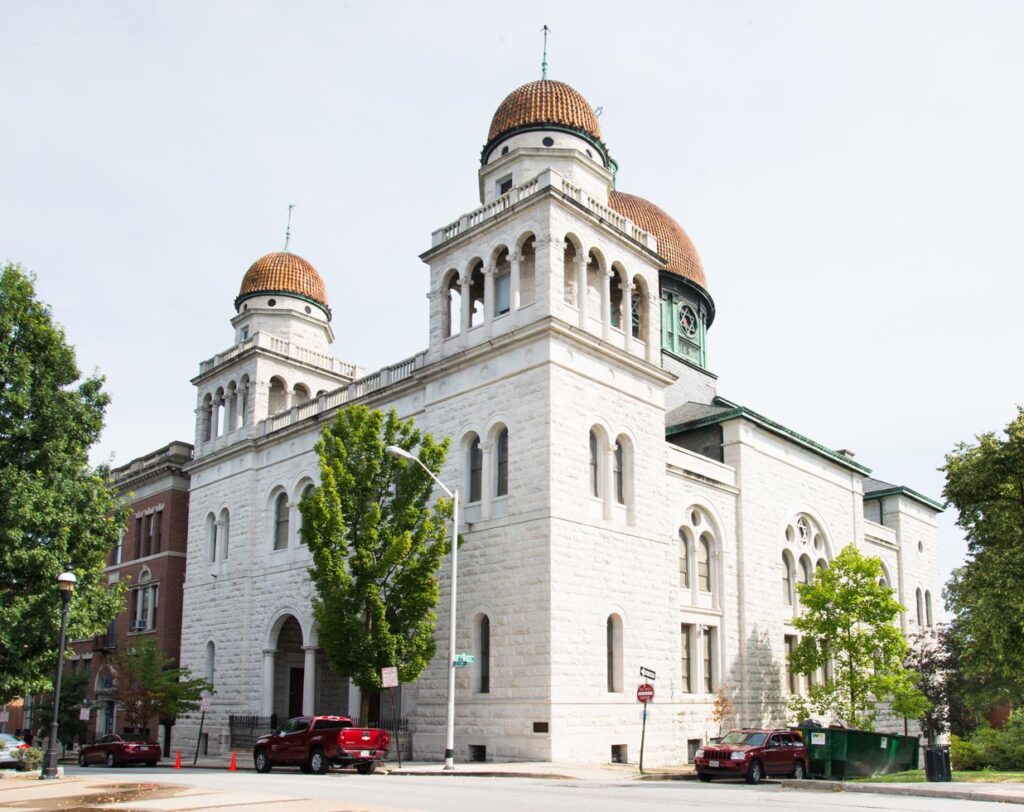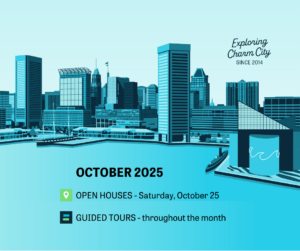The Baltimore Architecture Foundation is celebrating the history of AIA Baltimore in its 150th year by publishing select histories and highlights of Baltimore architecture from 1870 all the way through the 2000’s. These unique selections were written and edited by Charlie Duff.

Temple Oheb Shalom, designed by Joseph Evans Sperry (1893). Photograph courtesy of Vivian Marie Doering Photo courtesy Vivian Marie Doering
The 1890s opened with booming prosperity. A depression in 1893 stopped construction for about three years, and buildings built after 1896 differed greatly from those built before.
Architects of the early-’90s continued, in muted form, the exuberant eclecticism of the ‘80s. The skyscraper arrived in Romanesque garb (The Equitable Building, Joseph Evans Sperry, 1891) and the new suburbs like Sudbrook Park (1890) and Roland Park (1891) gave a home to the Shingle Style. Baltimore received an enduring landmark in the Patterson Park Pagoda designed by park superintendent Charles Latrobe (1892). Mount Royal Station, Baltimore’s finest train station, opened in 1896, designed by E. Francis Baldwin in the Italian Renaissance style.
Sperry’s Temple Oheb Shalom, built in 1892 at Lanvale and Eutaw, marked a change in architectural style. Sperry borrowed from Venice, Germany, and Spain, but he also made reference to the greatest landmarks of Old Baltimore, Latrobe’s Cathedral and Godefroy’s Unitarian Church. These American references would turn out to be prophetic, for the late-90s were as nationalst as the previous decade had been cosmopolitan.
The nationalism of the 90s found its expression in the revival of America’s Georgian architecture, a movement that started with the old money families who founded the Social Register (1894) and the Society of Colonial Wars (1892). They called this architecture “Colonial,” and they used it to distance themselves from recent European immigrants and “new money.”
Baltimore’s first Georgian Revival buildings appeared (in brown brick) in the north end of Mount Vernon. Although few big row houses were built anywhere in Baltimore after 1893—a salient fact—many houses from earlier decades were now being “Georgianized.”
The Chicago World’s Fair of 1893 created a giant exposition of French neo-baroque architecture, which recalled the age of Jefferson and Latrobe. Baltimore picked up on this change immediately, and the Baltimore Court House (Wyatt & Nolting, 1894) became one of the most famous American buildings of the Spanish-American War era.
All this was for the rich. The rest caught up slowly, and the typical Baltimore neighborhood changed little in the 90’s. Most people still lived in brick Renaissance row houses and worshipped in stone Gothic churches. But the 1890s began three lasting architectural changes: the birth of the skyscraper, the death of the giant expensive row house, and the rise of Colonial Revival. These changes redefined Baltimore. From 1896 to the present time, the showplaces of the city have been downtown skyscrapers and wealthy Colonial suburbs.


